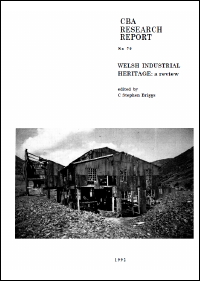CBA Research Reports
Council for British Archaeology, 2000. (updated 2020) https://doi.org/10.5284/1000332. How to cite using this DOI
Data copyright © Council for British Archaeology unless otherwise stated
This work is licensed under the ADS Terms of Use and Access.
Primary contact
Council for British Archaeology
92 Micklegate
York
YO1 6JX
UK
Tel: 01904 671417
Resource identifiers
- ADS Collection: 281
- DOI:https://doi.org/10.5284/1000332
- How to cite using this DOI
Welsh Industrial Heritage: a review Based upon the proceedings of a joint Cadw/CBA conference held in Cardiff, 5 December 1986
C Stephen Briggs (Ed.)
CBA Research Report No 79 (1992)
ISBN 1 872414 13 3
Abstract

Industrial Archaeology in Wales was the theme of the third Welsh Archaeological Conference held in December 1986 under the auspices of Cadw and the Council for British Archaeology at the National Museum of Wales in Cardiff. It has taken over four years to publish the papers presented then: but the delay has not been wholly disadvantageous. Collections of contributions to conferences are often unsatisfactory, even as records of the 'state of the art' at the time of their delivery: but here Dr Stephen Briggs has filled out what would have been a partial picture by including additional contributions so as to present a wider and deeper view than could have been offered on that one day. The articles naturally vary in scope and treatment, but they are all significant in their different ways.
Welsh industrial archaeology is the study of men and women at work, and their equipment and way of life (outside agriculture and seafaring, already provided for), throughout the whole of the discoverable history of Wales.
Contents
- Title pages
- Forward (pp v)
- Contents (pp vii-viii)
- List of illustrations (pp ix)
- Abbreviations and conventions used in text (p ix)
- List of contributors (pp x)
- Editor's preface (p xi)
- 1. Introduction: The growth of industrial archaeology in Wales by C Stephen Briggs (pp 1-8)
- Section I: Protection
- 2. Problems of protection by Richard Keen (pp 9-11)
- 3. Problems of scheduling; the role of Cadw by Jeremy Knight (pp 12-15)
- 4. The role of the National Parks (pp 16-22)
- Snowdonia, by Peter Crew and Merfyn Williams (pp 16-18)
- Brecon Beacons, by Chris Ledbury and C Stephen Briggs (pp 19)
- Pembrokeshire Coast, by C Stephen Briggs, S Gerrard, and C Kirkbride (pp 20-22)
- 5. Coastal limekilns in south-west Wales and their conservation by Richard Moore-Colyer (pp 23-29)
- 6. Slate quarries: problems of survey, conservation and preservation by Anthony Parkinson (pp 30-31)
- 7. The conservation of non-ferrous mines by C Stephen Briggs (pp 32-44)
- Section II: Recording
- 8. Problems of Recording by Marilyn Palmer (pp 45-48)
- 9. Industrial archaeology and the Royal Commission on Ancient and Historical Monuments in Wales by Stephen Hughes (pp 49-57)
- 10. Recording nineteenth century workers' housing: a case study by Jeremy Lowe (pp 58-61)
- 11. The National Trust Archaeological Survey: industrial sites at Aberglaslyn by John Latham (pp 62-65)
- 12. Industrial archaeology of Cwm Twrch by Dilys Powell (pp 66-72)
- Section III: Economic development and the industrial heritage
- 13. Industrial archaeology and the role of the Welsh Development Agency by Gwyn Griffiths (pp 73-74)
- 14. Site preservation and mineral development at Parys Mountain, Anglesey by C Stephen Briggs (pp 75-81)
- 15. The industrial heritage: British Coal by Ray Proctor (pp 82-86)
- Section IV: Museums, education, and recreation
- 16. Problems of presentation by Adrian Babbidge (pp 87-90)
- 17. Industrial archaeology and the National Museum of Wales by Geraint Jenkins (pp 91-94)
- 18. The National Trust and industrial archaeology by Richard Keen (p 95)
- Commercial sites
- 19. Bersham Ironworks by Stephen Grenter and Ann Williams (pp 96-100)
- 20. Dolaucothi Gold Mines by Charlotte Clough and C Stephen Briggs (pp 101-103)
- 21. Big Pit Mining Museum by Brian Davies (pp 104-106)
- Non-commercial sites
- 22. Merthyr Tydfil Heritage Trust by Jane Pearson (pp 107-114)
- 23. Kidwelly Tinplate Works by Susan Moore (pp 115-117)
- 24. Meligriffith Water Pump by Robin Williams (pp 118-124)
- Section V: The reuse of industrial monuments and landscapes
- 25. Welsh corn mills the past, present, and future? by Gerallt D Nash (pp 125-130)
- Section VI: Conclusions
- 26. Panel Archaeoleg Ddiwydiannol Cymru - The Welsh Industrial Archaeology Panel by Stephen Hughes (pp 131-136)
- 27. The future of industrial archaeology in Wales by C Stephen Briggs (pp 137-148)
- Appendices
- 28. List of Scheduled Ancient Monuments of industrial importance by David Strachan (pp 149-152)
- 29. List of metalliferous mine sites of industrial archaeological importance by C J Williams and David Bick (pp 153-160)
- Index by Kathleen Lyle and C Stephen Briggs (pp 161-168)
Download report
| Welsh Industrial Heritage: a review Based upon the proceedings of a joint Cadw/CBA conference held in Cardiff, 5 December 1986 (CBA Research Report 79) | 8 Mb |







